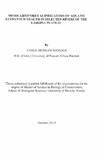| dc.description.abstract | Humans affect wetland ecosystems by changing cover, depleting resources, introducing waste
and changing natural communities. This poses a major challenge for aquatic ecosystem health in
the long run. In Laikipia, local resource managers have adopted expensive methods for
monitoring ecosystem health whose maintenance is not cost effective in the long term. The study
therefore examined the mesocarnivores of Laikipia and their role as indicator species. It also
determined their potential food resources. Six sites were selected for sampling during the period
between October 2012 and April 2013. Camera traps were strategically placed on the selected
foraging sites so as to obtain round the clock data on meso carnivore frequency of occurrences.
Other related riparian and aquatic fauna were sampled at each site. Physicochemical
characteristics of the water were assessed using standard probes and instruments. Data was
organized and later analyzed using R, STATVIEW® and PAST® statistical softwares.
Comparisons of non-normal data were made using Mann-U Whitney Test for two samples and
Kruskal Wallis Test for simultaneous comparisons of three or more data samples. Correlation
tests of mesocarnivore parameters and corresponding riparian and aquatic parameters were
carried out. Simple Linear Regression was used to confirm significant relationships between
variables that were found to be significantly correlated. The results revealed 110 camera trap
captures of meso carnivore representing a 1.963% camera trap yield rate, 54.5% were found to be
aquatic species and 45.5% as terrestrial species. There was a general lack of significant
relationships between mesocarnivore frequency of occurrence and all riparian and water fauna
parameters sampled. Food availability seemed to be the only factor that affected their frequency
of occurrence as indicated by the significant regression relationship between fish biomass and
meso carnivore frequency of occurrence (/=0.928, P<0.05). Correlations tests to determine
association of fish biomass and physicochemical water characteristics yielded no significant
relationships. Therefore, the only environmental parameter that mesocarnivore frequency of
occurrence indicates with significant accuracy is fish biomass. Mesocarnivores appeared to have
limited sensitivity to environmental variability. This is because they did not respond directly but
via food resources, which were directly influenced by variability in habitat conditions. However,
mesocarnivores responded directly to natural and human factors that affected habitat condition
and food availability. Hence can serve as indicators of external stresses, such as those caused by
pollution and habitat disturbance in aquatic ecosystems. The study recommends the use of more
specialized mesocarnivores as indicators of ecosystem disturbance and smaller aquatic organisms
as indicators of functional changes of ecosystems such as disruption of aquatic food chains. | en_US |

